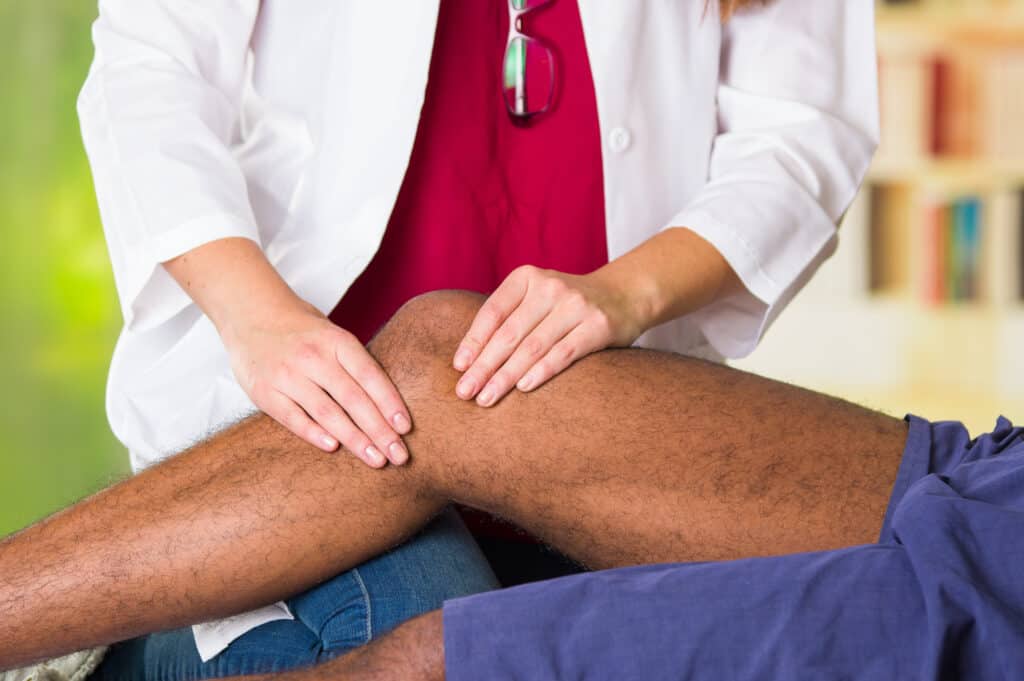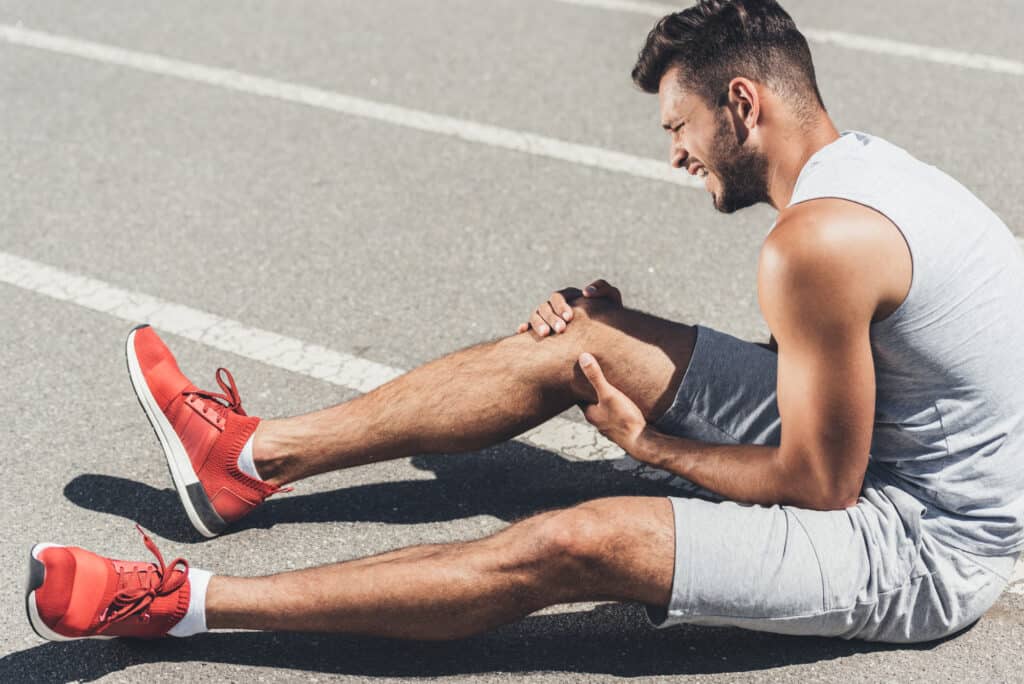
Are you looking for ways to strengthen your knees and improve your overall health?
Knee pain is uncomfortable and sometimes even debilitating – it limits mobility, affects daily activities, and generally makes life difficult. Our knees are a vital part of our body’s support system.
But we often take them for granted – until the pain starts. It’s a double-edged sword, too—it’s tough to exercise when your knee hurts, but lack of exercise can exacerbate the problem.
However, there are some simple ways to relieve knee pain and boost your joint strength without putting too much strain on your knees. Yes, you can protect your knees, enhance their function, and simultaneously reduce your future risk of injury.
More Blogs From RPM Physical Therapy:
How Can You Treat Sciatica Nerve Pain Without Surgery?
What Causes “Weak” Knees?

If your knee or knees always feel weak – like they’re going to buckle or give way all the time- there are many potential causes for this. So, you really need a physical therapist to fully evaluate your knees, spine, posture, and the rest of your body to diagnose properly. But the most common causes for “weak knees” are overuse, wear and tear, and arthritis.
However, in some cases, the cause can be something like a sprain or strain, infection, a torn ligament, or cartilage, ITB (iliotibial band) Syndrome, or a sedentary lifestyle.
So, in the best-case scenario and to fix the pain as quickly as possible, we’d recommend you book a consult with a physical therapist right away. But there are some general tips you can follow to strengthen your knees, like:
- Strengthen your quad muscles with exercises like squats and lunges: Do you have weak quad muscles? If you have knee problems, the answer is probably a resounding yes. That’s why it’s important to strengthen them, and doing exercises like squats and lunges can help with that. Not only do these exercises improve your quad strength, but they also benefit other muscles that have a knock-on effect on your knees. Squats, for example, can boost your glute and hamstring strength. Plus, lunges can also help improve your balance and stability. So, they’re an effective way to strengthen your quadricep muscles and take some pressure off your knees.
- Incorporate low-impact activities like swimming and cycling into your routine: Low-impact aerobics activities can increase overall fitness and build knee strength without putting too much strain on your body (and knees). For starters, why not give swimming a try? It’s a fantastic cardio workout that’s easier on the joints, making it an excellent choice for anyone with knee injuries or chronic pain. Cycling is another great option that’s easy to adapt to your skill level and fitness goals. Whether pedaling around your neighborhood or hitting the trails, you’ll feel the burn and get your heart pumping in no time and increase your knee mobility and flexibility at the same time. So why mix things up and try something new?
- Perform hamstring stretches to help keep the back of your knee limber: If you feel tightness or discomfort in the back of your knee, it could be a sign that your hamstrings need some TLC. Performing hamstring stretches regularly can help keep the back of your knee supple and reduce the risk of injury. Plus, there’s something so satisfying about feeling those muscles stretch and release after a long day. So, next time you’re winding down after a workout or want to give your body some love, don’t forget to add some hamstring stretches to your routine. Your knees will thank you.

- Incorporate balance exercises into your weekly routine to help maintain and improve knee coordination: Incorporating balance exercises into your daily/weekly workout routine can help improve knee coordination. Even if you don’t have any knee issues right now, it never hurts to strengthen the surrounding muscles and improve your balance. These exercises can range from simple standing on one foot to more challenging yoga poses or using a balance board. It can really make a difference in your overall stability and knee health.
- Stay hydrated because hydration can cause joint pain and contribute to weakness in the joints: Staying hydrated is one of the most important things you can do for your body. Not only does it keep your internal organs functioning properly, but it can also significantly impact your joint health. When you don’t drink enough water, your body can become dehydrated, leading to joint pain and weakness. So, whether you’re an athlete, working outside in the heat, or just going about your daily routine, it’s essential to ensure you’re getting enough fluids throughout the day. Keep a water bottle handy and drink up to keep your (knee) joints well-lubricated and in tip-top shape.
- Wear supportive shoes when exercising, and make sure they are comfortable: Whether you’re a seasoned pro or just beginning to dip your toe into the exercise world, it’s important to prioritize your footwear. Wearing supportive shoes is key to performing at your best and avoiding foot, ankle, and knee injuries. But that doesn’t mean sacrificing comfort. The two go hand in hand. When you invest in a pair of shoes with great support, you’ll likely find that they’re also incredibly comfortable. If your feet are happy, you’ll be happier too, and your performance will be even better.
The above knee-strengthening tips are great ways to strengthen and protect your knee joints. Still, the best and most effective way to strengthen your knees, improve joint health, and protect them from future injuries is to consult a physical therapist.
We find and fix the root cause of your knee pain, teach you how to look after your knees, and keep them pain-free long into retirement and beyond. At RPM Physical Therapy, we even offer a free consultation, including a telephone consultation or Discovery Visit with a physical therapist.
How Can A Physical Therapist Help Me Strengthen My Knees?

If your knees feel weak and the stretching and strengthening exercises you’ve been doing don’t provide the pain relief you need, it’s probably a good idea to talk to a physical therapist about taking control of your knee pain before it gets more serious.
Ignoring knee pain for too long is a one-way ticket to knee replacement surgery and/or permanent disability. But with the help of a physical therapist, you can restore your joints’ functionality and get free-flowing movement back.
Working with a physical therapist to build knee strength and stability can be a game changer. Over time, you’ll likely notice that your knee pain is decreasing and your mobility is increasing.
You can move more comfortably and likely enjoy other benefits, like improved posture, better balance, and increased strength and flexibility. Do all the things you love and participate in sports and other activity-led social activities with your friends and family, children, or grandchildren again – without pain, stiffness, or other discomfort. Priceless, right?
When it comes to knee strength, we’re an invaluable resource. Our typical treatment plans involve a combination of therapeutic movements to build strength in the muscles surrounding the knee joint and stretches to improve flexibility and range of motion.
Depending on your issues, we may also use hands-on physical therapy techniques, such as massage or joint mobilization, to help alleviate pain and improve mobility.
The knees connect your upper and lower body, and they bear a lot of weight. So, the exercises we teach you to strengthen all the muscles that support the knee, which reduces pain, helps prevent injuries and improves flexibility.

Some exercises you’ll learn, which you can also do outside of your sessions, include specific types of lunges, leg presses, squats, and knee extensions. Depending on your symptoms and the cause of your knee pain, we may ask you to do these with weights, resistance bands, or just your body weight.
You can significantly strengthen your knees, reduce pain, and improve stability through physical therapy. But you need to choose the right physical therapist to guide you through the process.
Throughout your treatment plan, we work closely with you to track your progress and adjust as needed to make sure you are making steady progress toward your goals.
Expect to be challenged but confident you receive the individualized attention and guidance necessary to achieve optimal results for your knee strength.
We guide you through the process with equal parts expertise and compassion. We take the time to listen to your concerns and goals and develop a personalized treatment plan that works for you. Motivating and encouraging you through the challenges of recovery while providing gentle support and guidance.
Would you like to book a free consultation with one of our physical therapists?
Dr. Jonathan Ruzicka is a Manual Therapist whose experience as a private therapist for professional athletes drove him to further his education attaining unparalleled skills in tissue mobility work, performance based rehab, injury prevention, myofacial release and joint mobilization to optimize human performance.
- 5 Lower Back Pain Stretches to Ease Your Discomfort - August 23, 2024
- How to Avoid Foot and Ankle Pain and Stay Active! - July 26, 2024
- Essential Stretches for Sciatica Pain: Your Path to Relief - June 10, 2024


